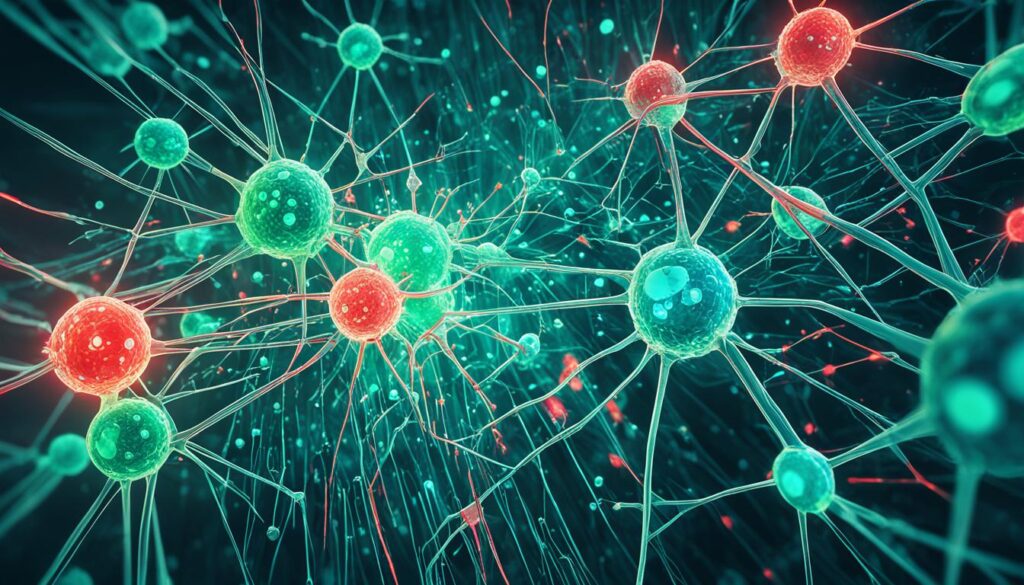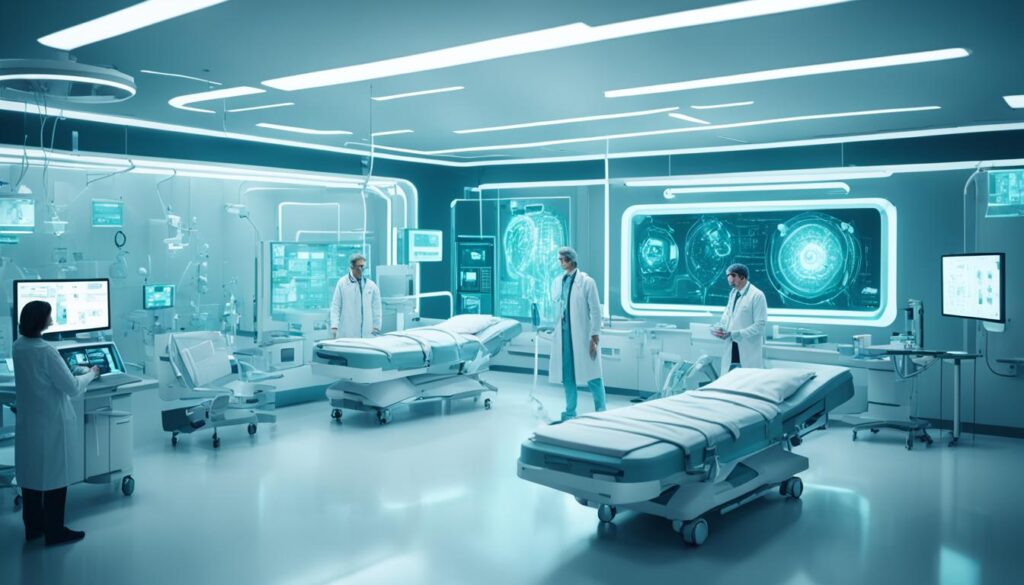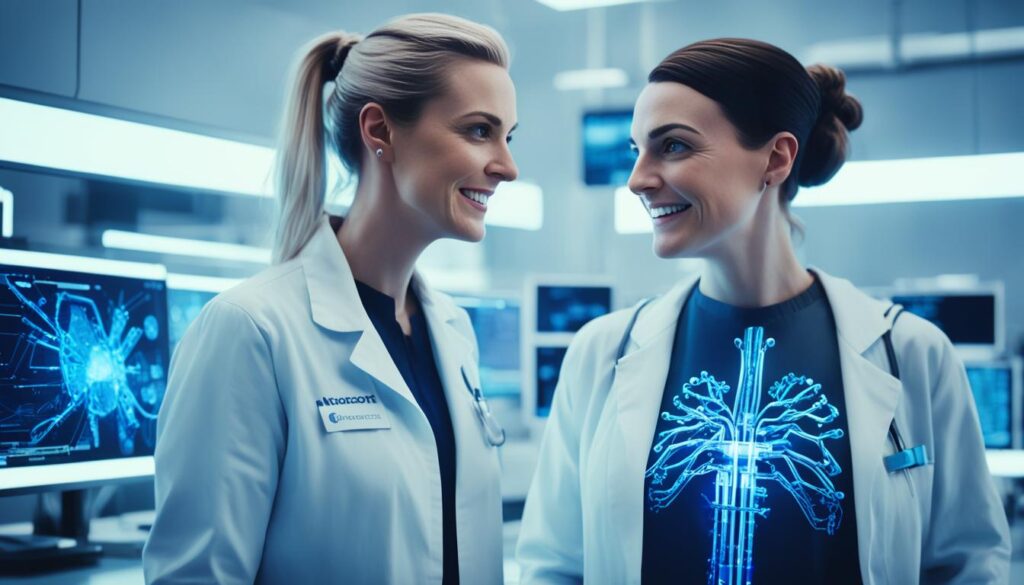Paige & Microsoft's next-gen AI models for Cancer Diagnosis Revealed
Did you know the AI server market will hit $187 billion by 2024? This shows how big of an impact artificial intelligence is having, especially in healthcare. Paige and Microsoft have teamed up to bring out new AI models for cancer diagnosis. These models will make finding cancer more accurate, helping doctors understand complex data better.
This big partnership uses over 3 million slides from 800 labs in 45 countries. They have data from more than 225,000 patients, making sure it’s diverse. Their new model, Virchow2G, has 1.8 billion parameters, making it the biggest pathology model ever. This big step forward, thanks to Microsoft’s supercomputing, aims to change how we detect cancer.
Key Takeaways
- Paige and Microsoft are working together to make cancer diagnosis better with AI.
- The AI server market is expected to hit $187 billion in 2024, showing fast growth.
- Virchow2G is the biggest pathology AI model, with 1.8 billion parameters.
- These AI models use data from over 225,000 patients for better accuracy.
- The new tech aims to give healthcare professionals better tools for finding cancer.
Introduction to AI in Cancer Diagnosis
Artificial intelligence is changing healthcare, especially in cancer diagnosis. It helps doctors make more accurate diagnoses, which helps patients get better care. AI looks at huge amounts of data to find patterns we can’t see.
AI models like the Virchow foundation models show how big a change this is. They were trained on over 3.1 million images from 225,000 patients in 45 countries. These models use smart algorithms to spot tiny details in cells.
Spotting cancer early is key to beating it. AI helps with this and can make imaging better. New tech could also predict biomarkers, helping plan treatments better.

AI is making a big difference in finding cancer. It promises a future where technology fights cancer more effectively.
Understanding AI Models in Healthcare
AI models in healthcare are very important. They help us understand how they work and their effect on patient care. There are different types like supervised and unsupervised learning. These are used in areas like oncology.
They each have their own job. This makes patient care more precise and effective.
Neural networks are a big part of healthcare AI. They can look through lots of data to find patterns that are hard for people to see. This helps make old ways of doing things better.
Training algorithms is key in machine learning in healthcare. It means the models get better over time with feedback. This makes sure the technology is safe and follows health rules.

Paige and Microsoft unveil next-gen AI models for cancer diagnosis
Paige and Microsoft have made a big leap in healthcare. They’ve created new AI models for cancer diagnosis. This AI collaboration uses the latest tech and expert knowledge. It aims to make cancer diagnosis more accurate and efficient.
These new models use artificial intelligence to help with pathology. This means better outcomes for patients.
The Collaborative Effort Behind the Technology
Paige and Microsoft have joined forces to change cancer diagnosis. They use their strengths to make tools for fast and precise tissue analysis. This teamwork leads to strong solutions for doctors, helping them make quick, smart choices.
Key Features of the New AI Models
The new AI models have some amazing features:
- They can look at images very closely, helping with tiny details.
- They’re very accurate, which helps catch cancer early and plan treatments.
- They use clinical data to make their findings even better and help with research.

These features automate routine tasks and boost what pathologists can do. This AI collaboration is bringing big changes to cancer diagnosis. It’s an exciting time for the future of cancer care.
Advancements in Cancer Detection Technology
The way we find cancer is changing fast. AI makes finding cancer better and faster. It looks at slides in a new way, catching things we might miss.
How AI Enhances Detection Accuracy
AI makes finding cancer more accurate. It looks at many things on slides to spot cancer cells. This helps avoid mistakes in finding cancer.
AI uses a huge amount of data from slides from many places. This helps it learn to spot cancer well. It’s getting better at finding cancer because of this.
Comparison to Traditional Diagnosis Methods
AI is better than old ways of finding cancer. Old ways can be iffy and not the same for everyone. AI is more reliable and accurate.
AI helps pathologists work better and find cancer more accurately. This is true for many types of cancer, like prostate cancer.
| Feature | AI Detection Technology | Traditional Diagnosis Methods |
|---|---|---|
| Accuracy | High, with minimized false positives/negatives | Variable, prone to human error |
| Speed of Analysis | Rapid processing of multiple samples | Time-consuming, dependent on manual review |
| Data Utilization | Utilizes extensive datasets for training | Limited to available historical patient data |
| Diversity of Analysis | Analyzes various cancer types simultaneously | Typically focused on one type at a time |
AI is a big step forward in finding cancer. It works with old ways to help patients more. This could make healthcare better for everyone.
Machine Learning Techniques in Cancer Diagnosis
Machine learning has changed how we fight cancer. It uses algorithms to learn from old data. This helps us understand and treat cancer better.
There are many ways to use machine learning, like supervised, reinforcement, and ensemble methods. Each one helps us in different ways.
Supervised learning is very important in AI for health. It uses labeled data to train models. This way, it can predict cancer types very well.
Reinforcement learning is different but useful too. It helps algorithms get better by learning from their actions. This can help in planning treatments.
Ensemble methods use many weak models to make a strong one. This makes predicting cancer types more reliable. It helps doctors make better choices.
To use machine learning well, we need to prepare the data carefully. This means cleaning and organizing it. Then, we pick the most important data to help the model work better.
Deep learning is a new way that’s changing cancer detection. It works like the human brain, looking at lots of data closely. This makes it more accurate in spotting cancer, which can save lives.
The Role of Artificial Intelligence in Early Detection
Artificial Intelligence is key in finding cancer early. Waiting too long to find cancer can make it harder to treat. AI uses smart algorithms to look at lots of data fast. This helps find cancer early.
Using AI in healthcare is vital for finding cancer early.
Benefits of Early Cancer Detection
Finding cancer early is good for patients and healthcare. The main benefits are:
- Improved Survival Rates: Finding cancer early means more chances of beating it, leading to higher survival rates.
- Less Aggressive Treatments: Catching cancer early means you might not need big surgeries or harsh treatments.
- Cost Efficiency: Treating cancer early is cheaper than treating it late, saving money for healthcare.
Challenges Faced in Deployment
Even though AI helps find cancer early, adding it to healthcare is hard. Big problems include:
- Data Privacy Concerns: Keeping patient data safe is very important. Using AI right is hard because of rules.
- Integration with Existing Systems: Many hospitals still use old systems, making it tough to add AI.
- Clinician Training: Doctors need training to use AI well.
| Benefit | Challenge |
|---|---|
| Increased survival rates | Data privacy concerns |
| Less aggressive treatments | Integration issues |
| Cost efficiency | Need for clinician training |
Case Studies: Success Stories with AI
AI is changing how we fight cancer. Real stories show how AI helps find cancer early and improve treatment. These stories show how AI makes a big difference in patient care.
A big success story is between Paige and Microsoft. They used AI to make diagnosing cancer better. This cut down on mistakes and helped doctors find cancer cells early.
Another great example is using AI to help with dementia. It looks at brain waves to find important info. This shows AI can work on many health issues, not just cancer.
The following table highlights several key examples of the successes achieved through AI in cancer diagnosis:
| Healthcare Institution | AI Application | Impact on Diagnosis | Outcome |
|---|---|---|---|
| Paige & Microsoft | Enhanced image analysis | Increased accuracy in identifying cancerous cells | Earlier detection and improved treatment options |
| Leading Cancer Research Center | Machine learning algorithms | Reduced false positives in screenings | More reliable diagnostics and patient management |
| University Hospital | AI-assisted pathology | Faster turnaround times for lab results | Enhanced patient care and satisfaction |
These stories show how fast AI is changing cancer diagnosis. The future looks bright with AI leading the way. As more AI success stories come, we’ll keep using technology to get better health care.
Future Implications of AI in Oncology
The future of AI in oncology looks bright. New tech is making cancer treatment better. AI helps make treatments that fit each patient’s needs. It also predicts how well treatments will work.
AI is changing how we get medical care. Now, patients can talk to doctors from home. This makes getting care easier, especially for those in far places.
More doctors are using AI in healthcare. Studies show AI helps doctors make better diagnoses. For instance, Paige and Microsoft worked together. They used over 3 million slides to make diagnoses better.
| Aspect | AI-Assisted Diagnosis | Traditional Diagnosis Methods |
|---|---|---|
| Accuracy Rate | Higher accuracy with AI models | Lower accuracy rates, more variability |
| Speed of Diagnosis | Rapid diagnosis within hours | Days to weeks for results |
| Cost-Effectiveness | Reduced costs due to efficiency | Higher costs over time due to delays |
| Patient Outcomes | Improved survival rates | Standard industry outcomes |
As AI changes healthcare, rules will change too. Doctors will need more training. Using AI in oncology means better care for patients. It also helps research move faster. This could lead to new treatments that save lives.
Conclusion
Looking back at the Paige and Microsoft partnership, we see a big change in AI for cancer diagnosis. Their work, especially with Virchow and Virchow2G, shows great tech and a goal to help patients more. These tools use a lot of data, making them very strong.
These new techs could change how we find cancer. They bring AI into cancer checks, aiming for early finds and custom treatments. But, we must think about the right use of patient data and make sure these tools help everyone.
Paige and Microsoft have made big steps in understanding cancer and setting new goals for oncology. I’m excited to see how these AI models will keep improving. They could really change cancer diagnosis and treatment.







